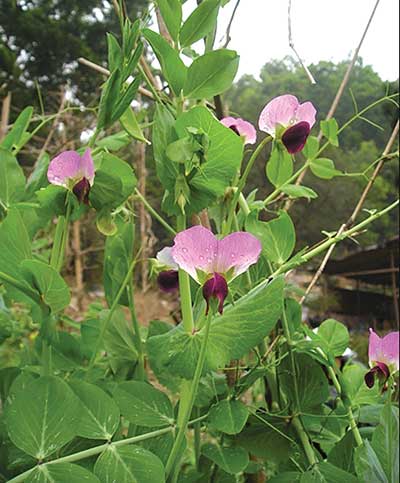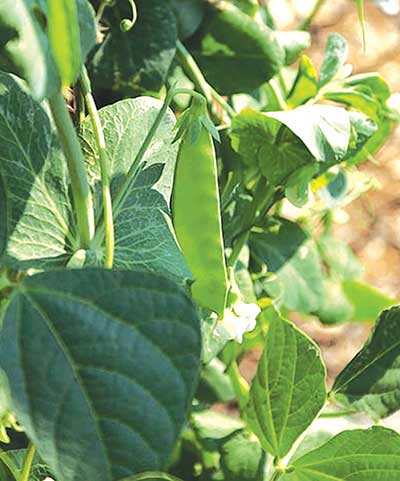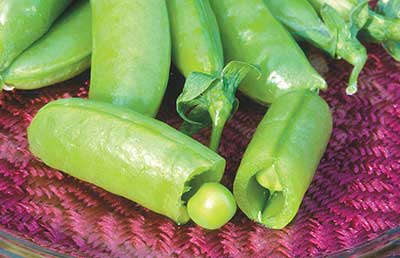 |
| Snow pea flowers. From https://commons.wikimedia.org/wiki/File:Snow_pea_flowers.jpg#/media/File:Snow_pea_flowers.jpg |
 |
| Snow pea. By JS – JS, CC BY-SA 3.0, https://commons.wikimedia.org/w/index.php?curid=10690536 |
 |
| Super Sugar Snap peas. Photo courtesy of Johnny’s Selected Seeds |
By Will Bonsall
When I was a kid, “peas” meant either the fresh (or canned or frozen) “garden peas” we enjoyed in early summer, or the “field peas” we ate as split pea soup or used as ammo in pea-shooters. I was in high school before I heard of a pea that could be eaten pod and all. In those days they were found mainly in Chinese restaurants. When I found them in seed catalogs, I immediately grew them and loved the flat, tender pods, which are picked before they get tough. What makes table peas tough, even when young, is a fibrous “parchment” membrane that lines the inside and makes the pod inedible; edible-podded peas lack that membrane.
Peas of Many Names
Edible-podded peas are variously referred to as snow peas, pod peas, Chinese peas, sugar peas, mangetout (“eat-all”) and cabbage peas (in old publications). All are called “edible-podded peas,” yet still another type of edible-podded peas – snap peas – is distinct. These are not picked when the pods are flat and the peas half-formed, but rather fully filled like a table pea, yet with much thicker, totally edible pods. The name “snap pea” compares them to “snap beans,” which used to be “snapped” to remove strings on the pods’ seams. Modern green beans don’t need to be de-stringed, but snap peas often do, especially when allowed to get full-grown. So do snow peas, and that’s easily done by snapping off the tip (where the pod connects to the peduncle) and pulling downward so that both strings tear away from the pod. Sometimes, especially with younger pods, the ventral string breaks without coming off – usually indicating that it’s too tender to be of concern when eating.
I’ve read that the edible-pod trait results from two genes, p and v; the p gene prevents the parchment layer from developing, while the v gene makes the pod wall thinner. I assume the v gene is missing in snap peas because their pods are unusually thick and fleshy.
Given the thick, succulent pod plus fully plump peas of snap peas, you might wonder why anyone would grow snow peas. It turns out they are suitable for different uses. For example, I tend to think of snap peas as a pulse, albeit a succulent one, with their full-sized seeds, while I think of snow peas as more like cabbage, peppers or celery (all, in fact, splendid accompaniments for snow peas in stir-fry). Moreover, snap peas are pretty big for stir-frying unless cut up first (so I usually steam them whole), while I often use whole snow peas in stir-fry. Probably the main reason I don’t grow more snap peas is that they don’t freeze well; they’re too rubbery, and there’s a limit to how many I can use before they go by. Snow peas, however, keep just fine lightly blanched and frozen.
Although cultivated peas originated in Ethiopia and the Near East, the edible-podded type in particular seems to have originated in the Orient. Only in more recent years have they caught on in western Europe, where they’re still much less popular than shell/garden peas or field/soup peas.
I handle my two favorite snow pea varieties differently. One, which I received as simply China Snow, is very productive but is best picked small and used whole. The other, a “carouby” type (especially Carouby de Maussane), can be allowed to grow larger and still be tender, although for stir-fries I usually cut them in three or four pieces. Incidentally, the word carouby, or caroube, in French refers to the carob tree and basically means any edible pod, as opposed to “gousse,” which means any pod.
Growing Peas
Some sources recommend spacing pea seeds 5 inches apart in a single row, but I learned many years ago from a neighbor that all types of peas do better sown relatively thickly – say, a pound of seed per 50 feet. I believe that’s because they give each other some welcome shade and moisture retention, although that may seem counterintuitive. Of course too much crowding encourages disease. The cost of seed is another consideration, but I save my own seed and you can too. I’ve sometimes left the late or gone-by peas to ripen for seed, but that risks unintentionally selecting for lateness, so I prefer to leave a few feet of row unpicked (marked with red string so that others don’t pick them by mistake). Still some peas inevitably get by you, and if not for seed, what to do with them? No problem; if they are fully ripe and dry down well for storage, they make excellent pea sprouts. They’re also OK for soup peas, especially if you split them in a grain mill set very coarsely and winnow off the hulls.
Both China Snow and Carouby de Maussane are quite tall, which I prefer. I’d rather provide support and get a much bigger yield than the so-called bush types, which yield less and need support anyway. Likewise with snap peas: While Cascadia may be ideal for commercial production, I find that for gardeners Sugar Snap with its heavy, pod-laden vines uses space better.
The late plant breeder Jim Baggett at Oregon State University greatly improved peas in general and snow peas in particular. He created a number of snow pea varieties that combined resistance to pea wilt, powdery mildew and pea enation mosaic virus. One of his releases, Oregon Sugar Pod II, is now one of the most widely grown snow peas in the world. I’m not aware of having much trouble with any of those diseases, but for West Coast market growers those qualities are essential. Incidentally Baggett always resisted pressure (from OSU) to patent his varieties, insisting that tax-funded breeding should be in the public domain.
Seed of most snow pea varieties is harder to clean than other types because their “constricted pod,” while small and crumbly, tends to envelop the seed in a fibrous web and hamper winnowing. I usually just rub them longer to release the ripe seed. Don’t be alarmed that the pea chaff is greyish-black. That’s just mold from the pods’ high sugar content, and although its dust is unpleasant to breathe, it doesn’t seem to affect the seed.
Peas are highly self-pollinating, so even if you’re growing several varieties or types in the same garden, you needn’t worry about crossing. I tend to prefer the purple-flowering snow pea varieties (some are white), if only because they’re prettier. I may chow them down in minutes, but I’ll be looking at them for many days; might as well enjoy.
Much of what we might say about edible-podded peas applies to any peas. All peas do best on some kind of trellis, and I use mostly 4- to 5-foot hex-wire (chicken fencing). More elegant and more organic is to make your own pea fence with fresh-cut alder brush, weaving it into a strong lattice by interlacing side shoots. One advantage to this is that despite your best efforts to make a flat or two-dimensional trellis, it will have some three-dimensional shape and many interstices to which the vines will cling much better. However wicked cunnin’ this looks, it is rather labor-intensive, especially with larger plantings. Hex-wire is much quicker to put up and lasts for years if properly stored between seasons. Vines don’t cling to it quite as well, thought, so I add a piece of binder twine lengthwise to both sides of the row, about halfway up the eventual height of the plants, weaving it into the wire fence every 6 to 8 feet. It’s much easier and more effective to tie up peas loosely before they start to fall away from the support. Some people use just a few lengths of twine to support peas; in my experience if that is adequate support, you’re sowing too thin.
Many people are obsessed with sowing peas very early in hopes of getting an earlier crop. That makes sense to a point, and research in the ’60s revealed that peas planted as soon as possible did produce an earlier crop, although not by as many days as the planting date. For example, peas planted a week earlier would be ready to harvest less than a week earlier. One might say it’s still worth it, given how hungry we are for fresh peas, but the peas sown a week later also yielded disproportionately better. Since I don’t eat most of my snow peas at harvest, but freeze most of them for year-round use, waiting another week for a larger harvest while enjoying last year’s frozen peas for that week is worthwhile.
Partly for that reason, I usually don’t sow successive plantings to extend the fresh-pick season, especially since peas maturing in midsummer heat are plagued with aphids, powdery mildew and other stress-related problems. I do plant a late crop in, say, early to mid-July for a fresh harvest in cool fall weather. That crop can often follow some very early crop such as lettuce or Egyptian onions.
Assuming previous crops were reasonably well nourished, I don’t worry about fertilizing snow peas, beyond a little wood ash (say, a 3-gallon bucket for 2,000 square feet). I don’t use lime, which doesn’t grow on my land, whereas wood ash does, plus it contains the whole spectrum of minerals, not just calcium. I ensure that my garden soil has abundant humus, which is guaranteed by my extensive use of forest residues – shredded leaves and chipped brush and no animal manure. Given good tilth and drainage, most of the disease problems I hear others discussing don’t bother my crops.
All of my intensive beds are 4 1/2 feet wide (not counting 1 1/2-foot paths), and peas always occupy the center of their bed, so neighboring pea rows are 6 feet apart. That’s lots of space in between for shorter companion crops. My general favorite with peas is carrots – two rows on either side – although I often do parsnips as well. The deep taproots of carrots and parsnips delve down out of the way of the shallow, air-breathing pea roots. Their different forms and nutrient needs make them convivial neighbors. I also companion with broccoli or summer cabbage (such as Early Jersey Wakefield), a single row on either side of the pea row, alternating in the crucifer row with lettuce, early kohlrabi or green onions, which don’t mind the light shade of the growing peas. (By the time peas are tall enough to create shade problems, the companion crop is usually nearly mature.)
At this point I actually plant and use more snow peas than shell peas, mostly in stir-fries. At this writing I have 15 to 20 pounds of snow peas in the freezer, so even in an off-year, I’ll still be eating all I want.
About the author: Will Bonsall lives in Industry, Maine, where he directs Scatterseed Project, a seed-saving enterprise. He is the author of “Will Bonsall’s Essential Guide to Radical Self-Reliant Gardening” (Chelsea Green, 2015). You can contact him at [email protected] and visit his gardens on two days this summer. See the “Daytripping” feature in this MOF&G for details.

